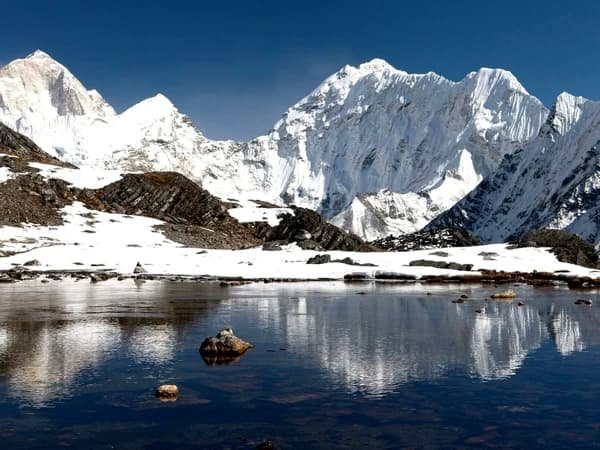Overview
The Makalu Base Camp Trek is a thrilling journey into one of Nepal's most remote and rugged areas, leading trekkers to the base of Mount Makalu (8,485m), the world's fifth-highest peak. This trek provides an unparalleled experience for those seeking pristine landscapes, challenging trails, and extraordinary mountain views. Here are the main highlights of the Makalu Base Camp Trek:
The trek culminates at Makalu Base Camp (4,870m), offering awe-inspiring views of Mount Makalu. From this vantage point, trekkers can admire Makalu’s grandiose south face and panoramic views of Mount Everest, Lhotse, and Baruntse. The scenery is particularly spectacular as you ascend higher, with peaks emerging from cloud cover, creating a dramatic and ethereal backdrop.
The trek traverses a rich tapestry of landscapes, starting with subtropical forests at lower elevations, then progressing through rhododendron and oak forests, alpine meadows, and eventually the glacial and snow-covered terrain closer to the base camp. The variety of ecosystems encountered along the route showcases Nepal’s natural diversity and the unique beauty of the Makalu-Barun region.
The route passes through Makalu-Barun National Park, one of the most ecologically diverse protected areas in Nepal. This national park is home to rare and endangered wildlife, including red pandas, snow leopards, Himalayan black bears, and over 400 species of birds. The park’s pristine wilderness remains relatively untouched, offering trekkers a chance to experience a pure and unspoiled natural environment.
The Makalu Base Camp Trek is known for its remote and challenging trails, demanding physical endurance and a high level of fitness. Trekkers must navigate steep ascents, descents, and high passes, including the Shipton La (4,216m) and Keke La (4,152m), which provide sweeping views of the surrounding peaks and valleys. This trek is ideal for those seeking an off-the-beaten-path adventure, away from the crowds of popular trails like Everest and Annapurna.
The trek offers a glimpse into traditional Sherpa and Rai culture, with stops at remote villages such as Seduwa and Num. These settlements provide a fascinating look into the lifestyles, customs, and resilience of the local people who have adapted to life in the high Himalayas.
Trekkers are welcomed with warm hospitality and can learn about the spiritual and cultural practices unique to this region.
As you trek through various altitudinal zones, you encounter a diverse range of plant species. The lower elevations are covered in lush bamboo forests and rhododendron groves, while the higher regions showcase alpine flora, moss, and lichens clinging to rocks and cliffs. During the spring season, the rhododendrons bloom in vibrant colors, making the trek visually striking and adding a unique charm to the trail.
The Makalu Base Camp Trek is one of Nepal’s lesser-trodden routes, offering an incredible sense of solitude and peace. Trekkers can immerse themselves in the sounds of nature without the interruptions of large trekking crowds, allowing for a deeply personal and meditative experience in the Himalayas.
The Makalu Base Camp Trek is an adventure of a lifetime, combining challenging terrain, rich biodiversity, and unparalleled mountain views. For experienced trekkers and those seeking a remote and raw experience in Nepal’s eastern Himalayas, this trek promises stunning rewards and memories that last a lifetime.
Highlights
- Breathtaking views of Makalu, the world’s fifth-highest peak
- flying over the lush hills and terraced fields of eastern Nepal,
- The trek takes you through the Makalu-Barun National Park, known for its rich biodiversity.
- Spot rare plants, including blooming rhododendrons and orchids,
- wildlife like red pandas, Himalayan tahr, and various bird species.
- Visit traditional Sherpa and Rai villages along the route,
- Experience the local customs, traditional architecture, and hospitality of the mountain communities.
What Can You Expect From Makalu Base Camp Trek?
The Makalu Base Camp Trek offers a unique and immersive experience in the Himalayas, characterized by its stunning natural beauty and cultural richness. Here’s what you can expect from this trek:
- Get breathtaking views of Mount Makalu, the world’s fifth-highest peak, along with impressive vistas of Everest, Lhotse, and Baruntse. The trek culminates at Makalu Base Camp, providing unparalleled panoramas.
- Expect a physically demanding journey that includes steep ascents, descents, and high-altitude passes like Shipton La and Keke La. The trek requires good fitness levels and endurance.
- Experience the unspoiled wilderness of the Makalu-Barun National Park, home to diverse flora and fauna. Enjoy the tranquility of this lesser-trodden route, far from the crowded trails of Everest and Annapurna.
- Discover the rich culture of the Sherpa and Rai communities. Visit traditional villages, interact with locals, and gain insight into their customs and lifestyles.
- Traverse through varied landscapes, from lush subtropical forests to alpine meadows and glacial terrain. The trek offers a rich ecological experience, showcasing Nepal’s biodiversity.
- Encounter unique wildlife, including red pandas and snow leopards, as well as a variety of bird species. The changing environments provide a beautiful backdrop for nature lovers.
- Enjoy a sense of adventure and serenity, as the trek allows for a personal connection with nature. The remote paths provide a peaceful atmosphere, perfect for reflection and solitude.
- The Makalu Base Camp Trek promises an unforgettable adventure filled with breathtaking views, cultural insights, and the beauty of remote landscapes. It’s ideal for those looking for a challenging trek away from the tourist crowds.










